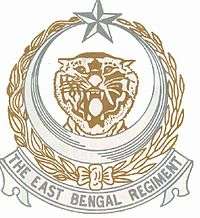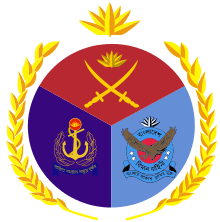East Bengal Regiment
| The East Bengal Regiment | |
|---|---|
|
Cap badge of the East Bengal Regiment | |
| Active | 15 February 1948 – present |
| Country | Bangladesh |
| Branch | Army |
| Type | Infantry |
| Size | 58 battalions |
| Garrison/HQ | Chittagong |
| Nickname(s) | The Tigers |
| Motto(s) | Grace, Strength, Speed |
| Colours | Colour of coagulated blood (BCC 37) |
| March | Chal Chal Chal |
| Mascot(s) | Royal Bengal tiger |
| Anniversaries | 15 February |
| Engagements | Battle of Chawinda, Indo-Pakistani War of 1965 , Bangladesh Liberation War |
The East Bengal Regiment (Bengali: ইস্ট বেঙ্গল রেজিমেন্ট) is an infantry regiment of the Bangladesh Army.
History
The previous name of East Bengal Regiment was Bengal Army. The East Bengal Regiment was formed on February 15, 1948 following Pakistan's creation from the Partition of British Raj in South Asia. As part of the agreement, the Muslim population of what was previously known as the British Empire in South Asia were given their own state of Pakistan, made up of West Pakistan and East Pakistan (initially East Bengal), which would be separate from the newly independent India. The infantry of the new Pakistan Army was made up exclusively of men from the west part of the country.[1] As a consequence, it was necessary to raise a regiment in the east; so two companies of Bengali pioneers from the Bihar Regiment were regimented into the 1st Battalion, East Bengal Regiment Senior Tigers under Lieutenant Colonel VJ Patterson as Commanding Officer (C.O.) and Major Abdul Waheed Choudhury as Officer Commanding (O.C.) Training Coy. Captain Sami Ullah Khan and Captain Abdul Gani in the lead of two Pioneer Companies (1256 and 1407). Between 1948 and 1965, a total of eight battalions were raised.[1][2]
1965 Indo- Pak War
After the Indo-Pakistani War in 1965, a new battalion the Lucky Tigers of the 6th Bengal, were raised in 1966.[3]
Bangladesh Liberation War
In March 1971, in response to a crackdown on locals in East Pakistan, the five battalions of the East Bengal Regiment mutinied and initiated the Bangladesh War of Liberation. The East Bengal Regiment formed the core of the liberation forces, which became known as the Bangladesh Forces. The structure and formation of the Bangladeshi Forces during the Liberation War of 1971 was determined at the Sector Commander's Conference that was held from July 11 to July 17, 1971.[1]
General Osmani was thereby appointed Commander-in-Chief of all Bangladesh Forces. Lieutenant Colonel M A Rab was appointed as Chief of Army Staff, and Squadron Leader M. Hamidullah Khan was assigned to the largest guerilla training camp of the liberation war at Chakulia, Bihar, as the Chief Military Representative of the Bangladesh government in exile, including the decision of formation of three brigades which were formed with East Bengal Regiments. The East Bengal Regiments that participated in the war were as follows:[1]
Z Force, under Major Ziaur Rahman, consisted of 1st, 3rd and 8th East Bengal Regiment. These regiments were formed during the war at Teldhala of Tura, Meghalaya, in 1971 by Major Ziaur Rahman. These three regiments principally constituted Sector 11, later commanded by for a brief stint Major Abu Taher, and subsequently by Squadron Leader M. Hamidullah Khan.
K Force, commanded by Major Khaled Mosharraf was created with 4, 9 and 10 East Bengal.
S Force, under Major K M Shafiullah, was created in October 1971 and consisted of 2 and 11 East Bengal. Further units were raised to replace those that remained stranded in West Pakistan. Following the foundation of Bangladesh, these units formed the core of the new army. However, the 7th Battalion was incorporated as 44th Battalion, Frontier Force Regiment in the Pakistan Army, which led to the raising of the 10th Battalion in 1971.
Today, The East Bengal Regiment is made up of around 50 battalions, and it plays a key role in safeguarding the sovereignty of the independent nation of Bangladesh through its traditional role as an infantry force.It is the 2nd largest regiment around the world.The Regiment also provides support to the civilian government as part of its 'aid to the civil power' responsibilities when it is called upon to do so. In 2000 Bangladesh Government on the recommendation from Army Headquarters formed Bangladesh Infantry Regiment out of some of the units of East Bengal Regiment to start with, and currently the key fighting element of the Army exceeds seventy strong regiments. So the name of late Major A Ghani is rooted to the root of the formation and expansion of the key fighting element of the Bangladesh Army. It was his vision, drive, self-sacrifice and dedication which gave the nation an army.
Major A Ghani was invalidated out of Army on health ground in December 1953 and later joined active politics and was elected as member of Provincial Assembly in 1954. He used the political platform to convince the Pakistani hierarchy that the East Pakistan needed to be self-reliant in the defense. The creation of the Ordnance factory, the training of youths in university in line with military training, the requirement of Cadet's training, in selective institution were his initiations. He did not live to see his vision come true but these proposals were soon materialized. East Pakistan Cadet College now Faujdarhat Cadet College was established in 1958 followed by the buildup of the Ordnance factory near Dhaka.
In November, 1957, he attended the 7th General Assembly of the World Veterans Federation that was held in Berlin, Germany. After the conference, he was on a tour of Germany and was keen on seeking their expertise in developing the industrial infrastructure of East Pakistan. On the night of November 11th, 1957, he died of a massive heart attack.
Role
The East Bengal Regiment is the largest formation of the Bangladesh Army, with battalions in each of the nation's fifteen infantry brigades. Its stated role is to engage and defeat an enemy in frontal combat, within a traditional infantry combat scenario, however, the regiment also provides aid to the civilian government when called upon and also contributes regularly to Bangladesh's peacekeeping commitments overseas. Bangladesh is among the troop contributing countries to the United Nations[4] and the Bangladesh Army is one of the nation's biggest earners of foreign currency as a result of the funding it receives for these contributions to the UN. The regiment currently provides four battalions to Bangladesh's UN commitments:
- UNOCI
- 12th Battalion, The East Bengal Regiment
- 13th Battalion, The East Bengal Regiment
- UNMIL
- 14th Battalion, East Bengal Regiment
- MONUSCO
- 15th Battalion, The East Bengal Regiment
See also
Notes
- 1 2 3 4 "The East Bengal Regiment ~ Bangladesh Defence". www.defencebd.com. Retrieved 29 June 2016.
- ↑ "Maj Abdul Gani". The Daily Star. 11 November 2014. Retrieved 6 October 2016.
- ↑ Sein, Maung Kyaw (20 May 2011). "Remembering a Tiger's Last Journey". Star Weekend Magazine. The Daily Star. Retrieved 5 October 2016.
- ↑ As of Dec 2008, Bangladesh was ranked second behind Pakistan and ahead of India in terms of numbers of troops deployed on UNPKOS. See official UN figures, available at: http://www.un.org/Depts/dpko/dpko/contributors/2008/dec08_2.pdf
References
- Sirajul Islam, Asiatic Society of Bangladesh. 2003. Banglapedia: National Encyclopedia of Bangladesh. Published by Asiatic Society of Bangladesh. ISBN 978-984-32-0582-7
- "British Indian Army's Infantry Officer who was Among former Pakistan Army's Senior most Bengali Commander & of 1st East Bengal Regement". blogspot.com. Retrieved 9 November 2016.
- "Abdul Waheed Choudhury Video | Interviews". OVGuide.com. Retrieved 9 November 2016.
- http://www.lehigh.edu/~amsp/2006/12/myth-of-martial-races.html
- Palit, D.K. 1972. The Lightning Campaign: The Indo-Pakistan War 1971 Published by Compton Press Ltd.
- http://www.defence.pk/forums/military-history/443-who-saved-lahore.html
•Colonel Tajul Ghani (Retired) Ex East Bengal Regiment (Son of Late Major A Ghani)

